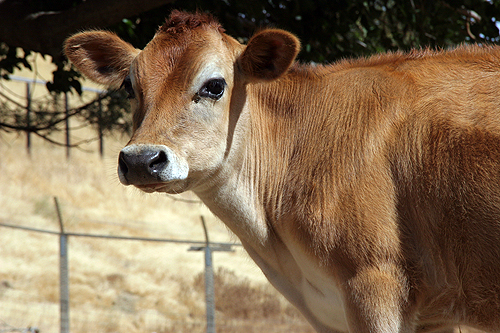 There is a little known practice in the dairy industry that we hope will be eliminated from California dairy farms soon - tail docking.
There is a little known practice in the dairy industry that we hope will be eliminated from California dairy farms soon - tail docking.The amputation of a cow's tail is a painful and unnecessary procedure done without the benefit of analgesics or anesthesia.
The American Veterinary Medical Association (AVMA), Canadian Veterinary Medical Association (CVMA) and the American Association of Bovine Practitioners all oppose tail docking as a management practice. The Netherlands, Germany, Denmark, Norway, Sweden and the UK have banned the practice altogether.
And now there is a bill before the California legislature that would ban this cruel practice in the state. SB 135 authored by Senator Dean Florez would prohibit the docking of cattle in California. As the #1 dairy state with nearly two million cows, this bill is an important piece of legislation for improving animal welfare.
If you live in California, take a moment to write a letter of support and thanks to Senator Florez for introducing this bill. When the bill is assigned a committee date, we will ask you to write committee members as well.
Please send letters to:
The Honorable Dean Florez
State Capitol, Room 313
Sacramento, CA 94248-0001
Animal Place is proud to support this bill. Sadie (pictured above) is a former dairy cow with a docked tail. During the fly season (spring, summer and fall), she has a difficult time protecting herself from the biting insects. Supporters of tail docking claims tail docking reduces udder hygience, increasing the chances for mastitis yet Sadie arrived at the sanctuary with a horrible case of mastitis that took 2-years to heal.
For more information on tail docking, see below:
About Cattle Tail Docking

What it is: The amputation of up to 2/3 of dairy cow's tail.
When it is performed: When cows are either 20-22 months old prior to their first calf or after weaning when they are 6-8 weeks old.
How it is done: The common practice is to use a rubber ring. This reduces the oxygen supply, causing atrophy and the tail will fall off within a week. On calves, a hot cauterizing knife is used to remove the tail.
Why it is performed: Supporters claim it reduces the risk of mastitis and increases udder cleanliness. It improves worker convenience in certain milking parlors where the worker must milk the cow from behind. A University of British Columbia study showed no difference in udder cleanliness between docked and undocked cows. Literature reviews show an increased fly count on rear legs of docked cows versus undocked cows and no reduction in the somatic cell count in milk from docked cows, showing no improved milk quality. According to Dairy Care Practices: Animal Care Series, Dairy Workgroup at UC Davis, "No data have been published to support the claims of improved milker comfort and health or better udder hygiene and milk quality (e.g. lower somatic cell counts) in cows with docked tails. "
How common the practice is: Between 50.5 - 80% of dairy farmers tail dock some of their dairy cows. Approximately 15% of dairy farmers tail dock their entire herds.
We hope you will take the time to write a letter of support of SB 135 and help improve the welfare of California's dairy cows.
-Marji Beach, Education Coordinator






0 comments:
Post a Comment